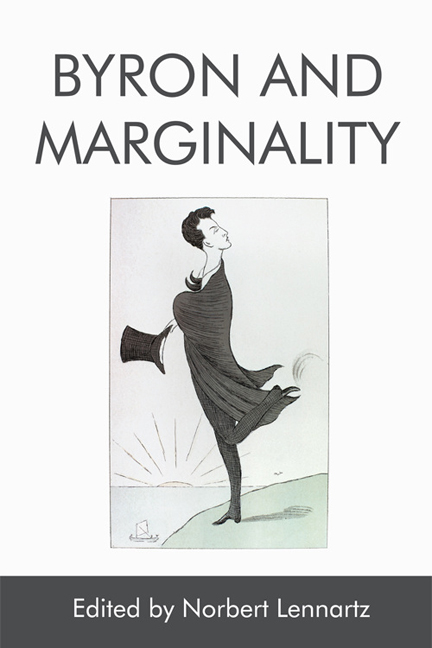Book contents
- Frontmatter
- Contents
- Foreword
- Acknowledgements
- Editions and Abbreviations
- 1 Lord Byron, Wandering and Wavering between the Centres and Margins of Romanticism: An Attempt at an Introduction
- I Byron’s Marginalisation in Romantic World Literature
- II Byron’s Marginal Identities and Places
- III Cherishing the Marginal – Marginal Genres in Byron
- IV On the Provocative Margins of Taste
- V Marginal Affairs – Visual and Paratextual Aspects in Byron
- List of Contributors
- Index
1 - Lord Byron, Wandering and Wavering between the Centres and Margins of Romanticism: An Attempt at an Introduction
Published online by Cambridge University Press: 06 May 2021
- Frontmatter
- Contents
- Foreword
- Acknowledgements
- Editions and Abbreviations
- 1 Lord Byron, Wandering and Wavering between the Centres and Margins of Romanticism: An Attempt at an Introduction
- I Byron’s Marginalisation in Romantic World Literature
- II Byron’s Marginal Identities and Places
- III Cherishing the Marginal – Marginal Genres in Byron
- IV On the Provocative Margins of Taste
- V Marginal Affairs – Visual and Paratextual Aspects in Byron
- List of Contributors
- Index
Summary
Romantic pugilism: the fight of the central versus the marginal
A few sporadic efforts have recently been made to write or to document the story of Romantic marginality in British literature, and while some of them concentrate exclusively on the hitherto forgotten and marginalised names of (mostly) female Romantics, others – and in particular this book – succumb to the vortex of the ‘big six’ and start to look for marginality not so much in the margins, but in the hallowed realms of the canon and its canonised heroes. Here one is immediately struck by the fact that canonicity is a dubious category (see Haekel, Chapter 3), since in Britain there was never – apart from a few fringe movements and associations such as the ‘Lake School’, the ‘Cockney School’ or the ‘Satanic School’ – a tightly knit and cohesive school of Romanticism (to which the German Romantics, with their gravitational centres in Jena, Weimar and Heidelberg, aspired). British ‘Romanticism’, by contrast, seems to be an academic construction levelled against the splintering of Romanticism into Romanticisms in the wake of Arthur O. Lovejoy, an arbitrary bracket that patches together six male individuals, cranks and nerds, who not only clamoured for singularity but also were eager to relegate their colleagues to the margins of insignificance and dilettantism, and, more often than not, to the edge of lunacy.
Having given up on his friend and interlocutor Coleridge as a hopeless case, William Wordsworth left nobody in any doubt that he was a, not to say the, central and canonical figure of a movement that, for want of a better term, later came to be known as Romantic period writing. Through the lenses of his contemporaries and adversaries, the reader, however, learns that Wordsworth, the venerated bard of Grasmere, was anything but a central or even chosen poet. William Hazlitt was rather struck by Wordsworth's provincialism, by his Cumbrian accent and by what he described as his ‘gaunt and Don Quixote-like’ appearance. Hazlitt's insinuation that Wordsworth resembles a tragicomic figure who, along with Torquato Tasso, became synonymous with the precarious borderline between reason and madness illustrates the relentless and sharp-tongued battle in which Regency writers were fighting for the central position of a movement that was scarcely more than embryonic at that time.
- Type
- Chapter
- Information
- Byron and Marginality , pp. 1 - 16Publisher: Edinburgh University PressPrint publication year: 2018

